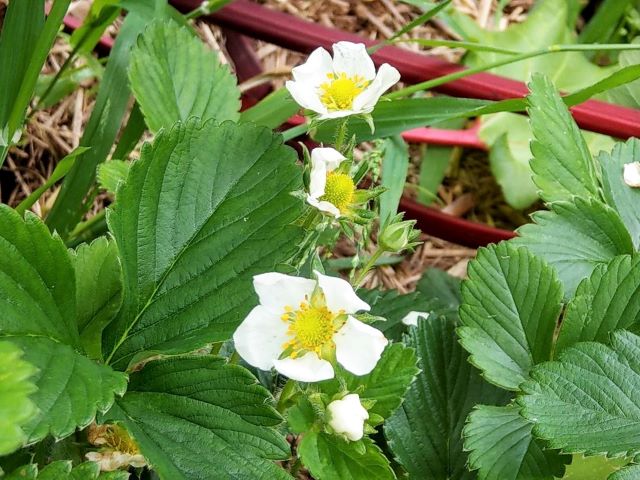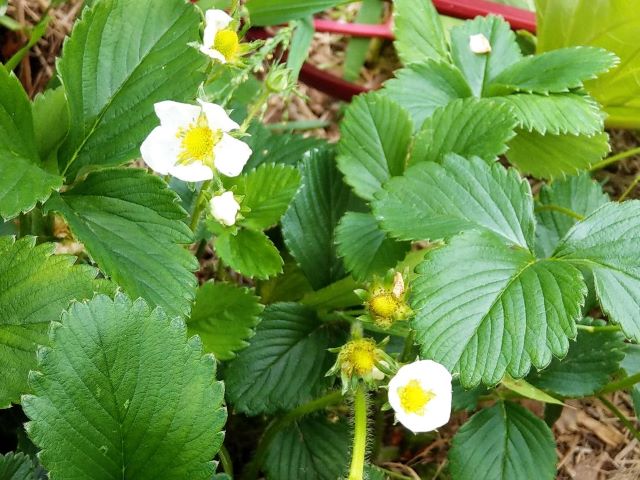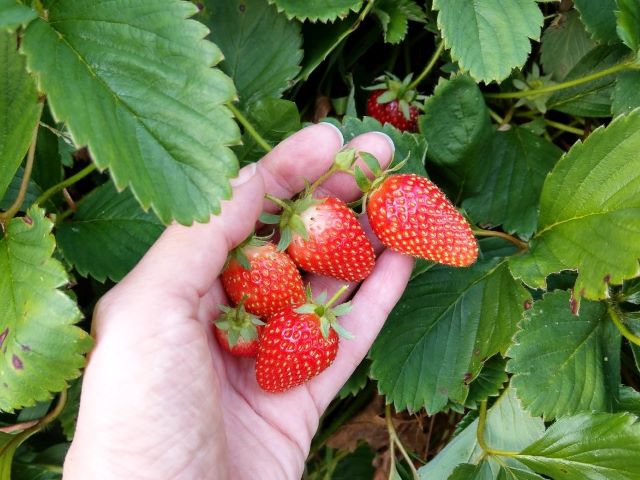When strawberry plants flower but don’t produce fruit, it can be very frustrating. Why do strawberry plants produce such beautiful flowers but not any delicious strawberry fruits?
As it turns out, strawberry plants flowering but not producing fruit is actually quite a common problem. Luckily, most of these reasons can be fixed or prevented.

So why does the strawberry plant flowers but no fruit? Here are the most common reasons:
- The strawberry plants are too young
- The wrong time of year for your variety (June-bearing vs. Everbearing vs. Day-neutral)
- Watering problems – typically too little water
- Lack of nutrients, or an overabundance of Nitrogen
- Wrong climate or temperature for strawberries
- The wrong soil for growing strawberry plants
- Wrong variety of strawberry plant for the area
- Strawberry plants aren’t getting enough pollination
Let’s look at each one in more detail.
Table of Contents
- Strawberry Plants Are Too Young To Produce Fruit
- The Wrong Time Of Year For Your Strawberry Plant To Fruit
- Watering Problems Cause Strawberry Flowers But No Fruit
- Inefficient Fertilizer Cause Strawberry Plants To Flower But Not Fruit
- Too Much Nitrogen Cause Strawberry Plants To Flower But Not Fruit
- Strawberries Flower But No Fruit Due To The Wrong Climate
- Strawberry Plant Flowers But No Fruit Because Of The Wrong Soil
- Strawberry Plant Flowers But No Fruit Due To The Wrong Variety
- Not Enough Pollination For Strawberry Plant Flowers To Develop Fruit
- Conclusion
Strawberry Plants Are Too Young To Produce Fruit
Many varieties of strawberry, and especially June bearing varieties, don’t produce fruit in their first year. Instead, they focus their energy on getting larger and putting out runners, and sometimes growing flower buds for the next year.
So if your strawberries are still in their first year of life, it’s likely that they could flower, but won’t produce any fruits. They need to focus all the energy they can on establishing themselves. In fact, it can be a good idea to pinch off strawberry flowers (but not the buds, only the open ones) during their first year, to help them get bigger for next year. This is the case for June-bearing and Everbearing varieties but not Day-neutral as they often fruit in their first year.
The Wrong Time Of Year For Your Strawberry Plant To Fruit
Strawberry plants are split into three main categories: June-bearing, Everbearing and Day-Neutral strawberries. As their names suggest, the different types bear fruit at different times of the year.
June-bearing strawberries will typically start to produce fruit in late May or early June, and produce for 4-6 weeks. Everbearing varieties, on the other hand, will start producing at the same time, but can produce through the summer and sometimes even into early fall.
Day-neutral strawberries are often considered the improved version of everbearing varieties. While everbearing strawberries might produce in the spring and then late summer, with a break in between, day-neutral varieties can produce straight through from spring to late summer or early fall. Day-neutral strawberries can also be grown as annuals, as they’ll fruit in their first year.
If you have June-bearing strawberries and it’s August, that could explain why your plants are flowering but not producing fruit. The strawberry plants might still flower but not have the energy to produce more fruit.
Additionally, June-bearing varieties often produce flower buds in the late summer/early fall. These buds stay on the plant over winter, and then bloom in early spring, eventually turning into berries. So if you notice buds that aren’t opening, it’s likely to be this.
Watering Problems Cause Strawberry Flowers But No Fruit
Often, overwatering is a common issue for plants. But, although they can still be overwatered, the problem for strawberries tends to be underwatering.
Strawberries have very shallow root systems, which usually only extend a few inches into the soil. The top few inches of soil tend to dry out fairly quickly, which means that strawberries might need more frequent watering than other plants.
This is especially true if they are being grown in pots, or in very warm spots. The top few inches of soil should never be allowed to dry out completely.
Of course, overwatering can still occur. Like most plants, strawberry plants don’t like to sit in excessive water. Don’t flood the plants, and make sure the soil isn’t waterlogged. If there’s too much water, root rot can set in, which will also heavily affect the crown of the strawberries. You definitely want to avoid that if you can.
Inefficient Fertilizer Cause Strawberry Plants To Flower But Not Fruit

If you have strawberry plant flowers but no fruit, you could have a lack of nutrients in the soil. Strawberries need feeding to help them grow and produce an amazing crop of strawberries.
Adding a healthy amount of organic compost to the soil once or twice a year along with an organic berry fertilizer like this one, is usually enough for strawberries to thrive. However, if you notice your strawberries are flowering and not fruiting, and it isn’t due to another issue, consider giving them a bit more fertilizer.
Too Much Nitrogen Cause Strawberry Plants To Flower But Not Fruit
On the other hand, strawberry plants can also have too much of certain nutrients, especially nitrogen. When strawberries have too much nitrogen in the soil, they will often grow very large, healthy green leaves but won’t flower at all, or produce flowers but no fruit.
So if your strawberries are growing big and leafy but not fruiting, they might have too much nitrogen. Avoid adding more fertilizer, and attempt to remove some of the excess nitrogen in the soil by flooding the soil with water and allowing it to drain.
Strawberries Flower But No Fruit Due To The Wrong Climate
Strawberries are a versatile plant, and there are many different varieties for growing in different regions. However, while they might be able to grow in all kinds of conditions, they will thrive in the right growing conditions.
The exact temperature for growing strawberries will depend on the variety. Many strawberry plants like daytime temperatures between 60-80 °F (15-26 °C). Typically there are strawberry varieties that grow best in cool to subtropical climates
While exact temperatures may vary, there are two things that remain true about what strawberries like.
One, they tend to grow best in moderate climates, where the temperatures aren’t too extreme in either the high or low range.
And two, strawberries grow best when it is warm during the day and cooler at night. If nighttime temperatures are not much colder than daytime ones, strawberries won’t grow as well. They need the reprieve from the heat in order to better use their stored-up energy to focus on growing.
If strawberries get too hot, or there’s a cold snap, it can cause growing problems. While the strawberry plants might keep growing, they will struggle to produce flowers and even more to make fruit.
So, to know exactly what temperature your strawberry plants prefer, find information on their specific variety. As a general rule though, strawberries like more moderate climates, and love it when nights are colder than the days.
Strawberry Plant Flowers But No Fruit Because Of The Wrong Soil
Sometimes, strawberry plants flower but don’t produce fruit comes down to the wrong soil.
Whether in pots or in the ground, strawberry plants need soil that is well-draining. While this means they need to be watered more often, it also means the crowns won’t be sitting in too much moisture, which can damage the plant.
Additionally, the soil should be rich in nutrients. If your soil isn’t very nutrient heavy, or it’s been used for more than 6 months, add in some organic compost along with an organic berry fertilizer to give strawberries the food they need to produce delicious berries.
So, while your average potting soil might work for strawberries, they will thrive if you give them more nutrients and make sure that the soil drains well.
Strawberry Plant Flowers But No Fruit Due To The Wrong Variety
Strawberry plants have been adapted and modified many, many times, perhaps more than a lot of other common garden plants. The reason for this is simple: growers want strawberries that will grow well in their specific climate.
Because of this, many varieties of strawberries are designed to grow in one region. While they probably can grow in others, they might not thrive as much, and that can lead to strawberry plant flowers but no fruit.
So, when buying strawberry plants or seeds, it’s good to know what variety you’re getting, and where it’s meant to grow. If you live in Maine, don’t get a variety designed for Florida – it probably won’t grow well!
Many local plant nurseries or garden stores will have varieties that grow well in your area. But when buying online, or from larger chain retailers, you might find varieties that don’t fit your area at all. Make sure to do your research, and remember that you can always ask a nursery worker for assistance.
If you can’t find strawberries designed specifically for your region, then look at temperatures. For example, if you know that your average spring temperatures range from 70-95 °F (21-35 °C), look for strawberries that thrive in that temperature range.
Not Enough Pollination For Strawberry Plant Flowers To Develop Fruit
Most, if not all, varieties of strawberry plants are hermaphroditic. This means that the flowers on the plant have both male and female parts, and therefore are capable of self-pollinating.
However, while strawberries can technically pollinate themselves, often this alone isn’t enough to fully pollinate the flowers. This results in strawberry plants that flower but don’t have fruit or strawberries that are misshapen.
So it can still be a good idea to help your strawberry plants get pollination from the wind and bees as well. While it isn’t necessary, you will likely get a better crop if your berries have more sources of pollination than just themselves.
Luckily, encouraging pollination is usually simple. If you have your plants outside, the local bees and insects will help pollinate strawberry flowers.
If your strawberries still aren’t getting enough pollination, you might need to do something to draw more bees.
Planting more flowers is a great way to attract bees. These can be ornamental flowers, or other edible plants like lavender or nasturtiums.

Of course, if you’re growing strawberries inside, it could be harder to get pollination. Without wind and bees, the strawberries only have self-pollination. So pollinating your strawberries by hand can help you get a bigger crop.
To do this, take a small brush and, one at a time, gently swirl it around the inside of your strawberry flowers. This will transfer pollen between them, and hopefully, help them grow the fruit you really want!
Conclusion
So from watering issues to too much nitrogen, the wrong climate to lack of pollination: there are a lot of reasons that a strawberry plant flowers but no fruit. As you can see, most of them can be treated or prevented with the right kind of care.
Remember to get the right variety of strawberries for your climate, potentially pinch the flowers in the first year for June-bearing strawberry plants, make sure they have enough water, and ensure strawberry plants are getting pollination. Then you’ll be on your way to a big, delicious crop of juicy strawberries.
- How To Grow Strawberries At Home – Ultimate Growing Guide
- What’s Eating My Strawberries? Answered!
- Why Blueberry Bush Flowers But No Fruit (With Solutions)
- Does Rhubarb Die After Flowering? Answered!
- Why Is My Rhubarb Thin? (And How To Fix It)
- Why Is My Raspberry Plant Dying? Causes and Solutions
- Why Is My Rhubarb Dying? Causes and Solutions
- Cantaloupe Flowering But No Fruit? Causes And Solutions
- Feijoa Flowers But No Fruit? Causes and Solutions
